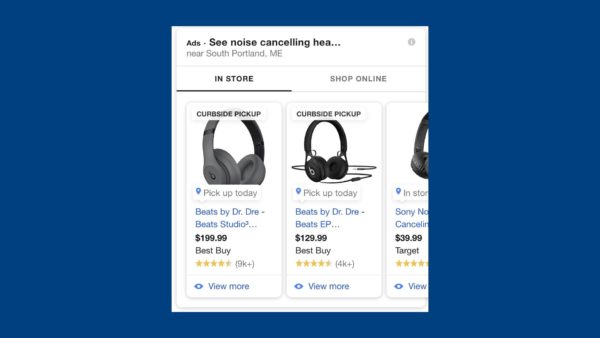Google tests ‘Curbside Pickup’ badge for local Shopping ads
Local Inventory Ads gain prominence with “In store” mobile experience and “Curbside pickup” option.

One area where Google has an edge over Amazon? Local retail. In response to COVID-19 restrictions, Google has been giving local businesses more messaging options such as special store hours, pickup and delivery options and more in Google My Business. Now, it has also enabled “Curbside pickup” badges for Local Inventory Ads.
Curbside pickup. Google has been piloting the “Curbside pickup” feature with a small group of Local Inventory Ad (LIA) retailers since the end of April. Officially announced Monday, the badges appear at the top of eligible ads on both mobile and desktop results.
To get “Curbside pickup” enabled in your LIAs, you’ll need to meet the criteria for Store Pickup and offer same-day or next-day pickup from the time the order is placed. To join the beta, you’ll need to reach out to your Google reps or fill out this form.
The feature is available where Local Inventory Ads have launched: Australia, Austria, Brazil, Canada, Denmark, France, Germany, Japan, Netherlands, Norway, Sweden, Switzerland, the UK and the U.S.
“In Store” tab. Google also shows an “In Store” and “Shop Online” slider on mobile searches when it determines there might be local intent. This feature has been out for a while, but the GIF below from Emil Kirk, senior paid search specialist at performance marketing agency s360 in Denmark, shows how the In Store and Shop Online slider in the Shopping ad carousel on mobile works.
Users can either click on either tab or swipe along the carousel to navigate between the “In Store” and “Shop Online” options.

Why we care. E-commerce has surged during the pandemic, but the shift in consumer demand during the pandemic has also put great strain on e-commerce fulfillment capabilities. Amazon, as the key example, has experienced significant shipping delays, stopped accepting non-essential inventory from sellers for a period and hired more than 175,000 fulfillment workers since mid-March. In response to slow e-commerce delivery times, Google says searches for “in stock” have increased more than 70% from the week of March 28 to April 4.





